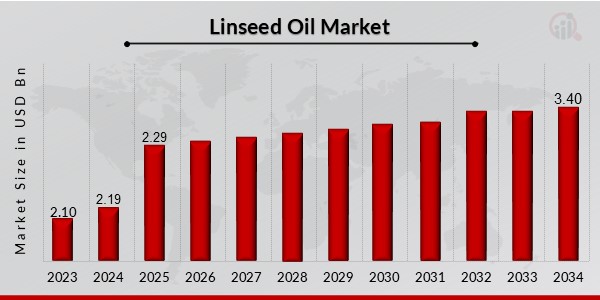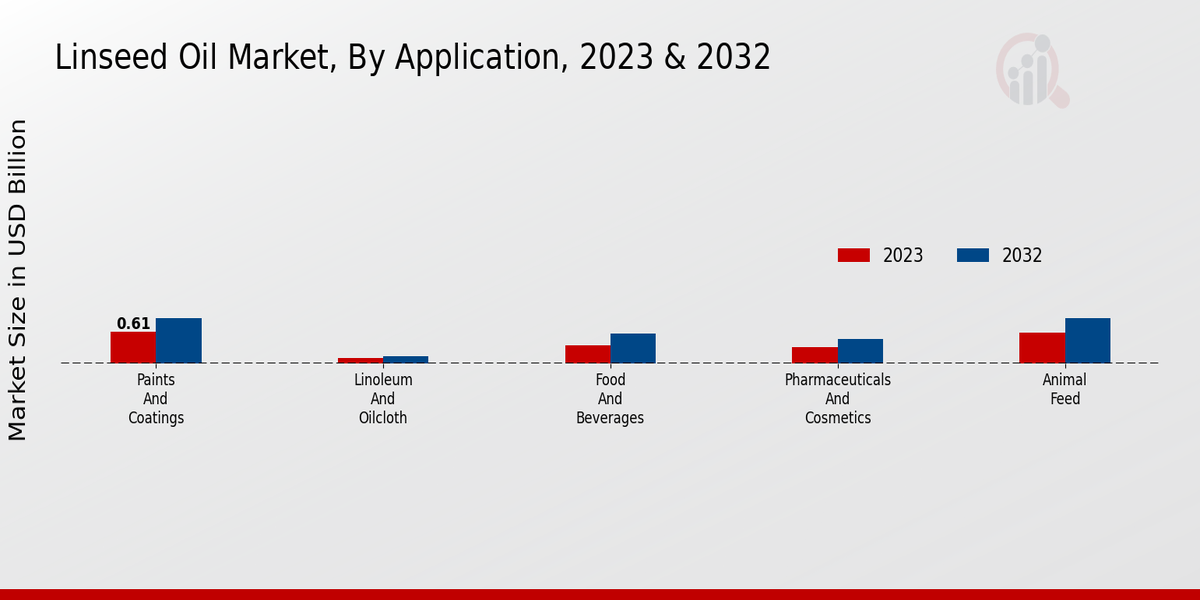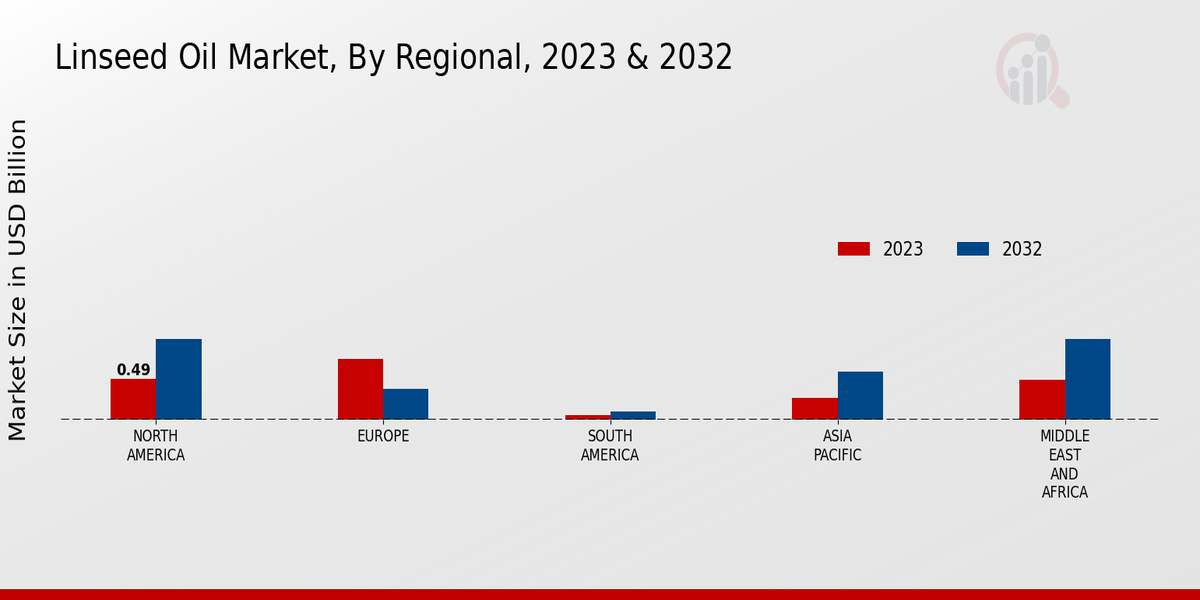Global Linseed Oil Market Overview
Linseed Oil Market Size was estimated at 2.19 (USD Billion) in 2024.The Linseed Oil Industry is expected to grow from 2.29(USD Billion) in 2025 to 3.40 (USD Billion) by 2034. The Linseed Oil Market CAGR (growth rate) is expected to be around 4.5% during the forecast period (2025 - 2034).

Source: Primary Research, Secondary Research, MRFR Database and Analyst Review
Key Linseed Oil Market Trends Highlighted
Key market factors include an increase in the popularity of natural and organic products, growing concern for health, and more knowledge regarding the advantages of linseed oil for skin and hair. Opportunities stem from the growth of various nutraceutical and cosmetic markets as well as a rising need for linseed oil as a green substitute for industrial oils.
Recent trends such as the increasing acceptance of cold-opened linseed oil due to its health benefits, the introduction of novel methods, and the development of functional foods and drinks fortified with linseed oil can all be seen in the industry. The demand for organic and non-genetically modified linseed oil is increasing in the market on account of peoples’ increasing desire for health and health amenities. Additionally, chronic diseases are on the rise alongside increased health promotion that aims to prevent diseases, both of which would help in the expansion of the market.
Linseed Oil Market Drivers
Rising Demand for Linseed Oil in Paints and Coatings
The primary driver behind the rising demand within the Linseed Oil Market is the paints and coatings industry. Linseed oil is a natural, renewable resource that has been used for centuries in the manufacture of paints and coatings. The reason behind this is the excellent film-forming capacity of linseed oil, durability, and resistance to moisture and UV radiation. The growing demand for sustainable and ecologically-friendly products in the construction and automotive industries is also raising demand for linseed-oil-based paints and coatings as opposed to traditional synthetic and, worse yet, petroleum-based ones.Finally, there is a dramatic increase in interest in linseed oil both among regular customers and in the industry because of the health benefits and environmental safety it provides-low levels of VOC and, being non-toxic, safety in both use and production.
Expanding Applications in Food and Pharmaceuticals
Another important factor that drives the Linseed Oil Market is the growing application of oil in the food and pharmaceutical industries. Linseed oil is a rich source of omega-3 fatty acids, which are vital to the health of humans. The rising demand for omega-3 supplements and functional food is driving the growth of the linseed oil market in these industries. Moreover, the oil is also used in traditional medicine and skincare products due to its anti-inflammatory and antioxidant properties.
Growing Demand in Emerging Economies
The rising demand for linseed oil in emerging economies is also contributing to the growth of the Linseed Oil Market. Countries in Asia-Pacific and Latin America are experiencing rapid urbanization and industrialization, which is leading to an increased demand for paints, coatings, and other industrial products that utilize linseed oil. Moreover, the growing health consciousness among consumers in these regions is driving the demand for linseed oil-based food products and supplements.
Linseed Oil Market Segment Insights
Linseed Oil Market Application Insights
The application segment plays a crucial role in shaping the Linseed Oil Market. Among the key applications, Paints and Coatings hold a significant market share and are projected to maintain their dominance throughout the forecast period. The increasing demand for eco-friendly and sustainable paints and coatings, coupled with the rising construction activities globally, is driving the growth of this segment. Linoleum and Oilcloth, traditional floor coverings made from linseed oil, are witnessing a resurgence in popularity due to their durability and aesthetic appeal.
This segment is expected to experience steady growth over the coming years. The Food and beverage industry utilizes linseed oil as an ingredient in various products, including salad dressings, mayonnaise, and bakery items. The growing health consciousness among consumers and the increasing demand for natural and organic food products are contributing to the growth of this segment. Pharmaceuticals and Cosmetics applications of linseed oil are gaining traction due to its anti-inflammatory and moisturizing properties. The use of linseed oil in skincare products, hair care products, and dietary supplements is expected to drive the growth of this segment.
Animal Feed is another important application of linseed oil, particularly in the poultry and livestock industries. The high nutritional value and energy content of linseed oil make it an ideal feed supplement for animals. The growing demand for animal protein is expected to fuel the growth of this segment. Overall, the Linseed Oil Market is expected to witness robust growth in the coming years, driven by the increasing demand from various applications.

Source: Primary Research, Secondary Research, MRFR Database and Analyst Review
Linseed Oil Market Production Process Insights
Solvent extraction, cold-pressing, and enzyme extraction are the three primary production processes for linseed oil. Solvent extraction, which uses hexane or other solvents to extract oil from linseed, dominates the Linseed Oil Market, accounting for over 60% of total production. This method is cost-effective and efficient, making it suitable for large-scale production. Cold-pressing, a mechanical process that does not involve the use of solvents, retains more nutrients and flavor in the oil but has a lower yield. Enzyme extraction, a relatively new method, utilizes enzymes to break down the oil-bearing cells, resulting in higher oil yield and better quality.However, it is more expensive than solvent extraction and cold-pressing. The choice of production process depends on factors such as desired oil quality, production capacity, and cost considerations.
Linseed Oil Market Form Insights
The Linseed Oil Market segmentation by Form includes Raw, Refined, and Organic. Raw linseed oil is the unprocessed form of linseed oil obtained directly from pressing flax seeds. Refined linseed oil undergoes additional processing to remove impurities and improve its quality and stability. Organic linseed oil is produced from organically grown flax seeds, following organic farming practices and standards. The rising demand for linseed oil in various industries, including food, pharmaceuticals, and personal care, is driving market growth.Raw linseed oil holds a significant share of the market owing to its wide usage in the production of paints, varnishes, and other industrial applications. Refined linseed oil is preferred in the food industry due to its improved taste and nutritional profile. Organic linseed oil is gaining traction due to increasing consumer preference for organic and natural products.
Linseed Oil Market Regional Insights
The Linseed Oil Market segmentation by region offers insights into the market's performance across different geographies. North America, Europe, APAC, South America, and MEA are the key regional segments. North America held a significant market share in 2023 and is projected to maintain its dominance throughout the forecast period. The region's well-established food and beverage industry, along with growing health consciousness, drives demand for linseed oil. Europe is another major market, owing to the increasing adoption of organic and natural products.The APAC region is anticipated to witness substantial growth due to rising disposable incomes, urbanization, and changing dietary habits. South America and MEA are expected to contribute moderately to the overall market growth, with increasing awareness about the health benefits of linseed oil.

Source: Primary Research, Secondary Research, MRFR Database and Analyst Review
Linseed Oil Market Key Players And Competitive Insights
Major players in the Linseed Oil Market industry are constantly innovating and developing new products to meet the changing demands of customers. Leading Linseed Oil Market players are focusing on expanding their global presence through strategic partnerships and collaborations. The Linseed Oil Market development is driven by increasing demand from various end-use industries such as paints, coatings, and food. The competitive landscape of the Linseed Oil Market is expected to remain fragmented, with a number of small and medium-sized players operating in the market.
Archer Daniels Midland Company is a leading player in the Linseed Oil Market. The company offers a wide range of linseed oil products, including cold-pressed, expeller-pressed, and refined linseed oil. Archer Daniels Midland Company has a strong global presence, with operations in over 190 countries. The company's commitment to innovation and sustainability has helped it maintain its position as a leading player in the Linseed Oil Market.
Cargill, Incorporated is another major player in the Linseed Oil Market. The company offers a variety of linseed oil products, including linseed oil for paints, coatings, and food. Cargill, Incorporated has a strong global presence, with operations in over 125 countries. The company's focus on quality and customer service has helped it to gain a loyal customer base.
Key Companies in the Linseed Oil Market Include
- Cargill, Incorporated
- Lallemand Health Solutions
- Natural Factors Nutritional Products Ltd.
- FlaxSeed Oil International
- IMCD
- DSM Nutritional Products
- CHS Inc.
- SigmaAldrich
- NOW Foods
- The Hain Celestial Group, Inc.
- Stepan Company
- Bunge Ltd.
- Rembrandt Enterprises
- LignoTech USA LLC
- ARCHERDANIELSMIDLAND COMPANY
Linseed Oil Market Industry Developments
The Linseed Oil Market is anticipated to expand at a CAGR of 4.48% from 2024 to 2032, reaching a projected value of USD 2.97 billion by 2032. This growth is attributed to the rising demand for linseed oil in various industries, including paints and coatings, pharmaceuticals, and food. The increasing awareness of the health benefits associated with linseed oil is also driving market growth. Key players in the market are investing in research and development to enhance the quality and functionality of linseed oil, further boosting market expansion. Recent developments include the launch of new linseed oil-based products and strategic partnerships between manufacturers and suppliers.
Linseed Oil Market Segmentation Insights
-
Linseed Oil Market Application Outlook
- Paints and Coatings
- Linoleum and Oilcloth
- Food and Beverages
- Pharmaceuticals and Cosmetics
- Animal Feed
-
Linseed Oil Market Production Process Outlook
- Solvent Extraction
- Cold-Pressing
- Enzyme Extraction
-
Linseed Oil Market Form Outlook
-
Linseed Oil Market Regional Outlook
- North America
- Europe
- South America
- Asia Pacific
- Middle East and Africa
| Report Attribute/Metric |
Details |
| Market Size 2024 |
2.19(USD Billion) |
| Market Size 2025 |
2.29(USD Billion) |
| Market Size 2034 |
3.40(USD Billion) |
| Compound Annual Growth Rate (CAGR) |
4.5% (2024 - 2032) |
| Report Coverage |
Revenue Forecast, Competitive Landscape, Growth Factors, and Trends |
| Base Year |
2023 |
| Market Forecast Period |
2024 - 2032 |
| Historical Data |
2019 - 2023 |
| Market Forecast Units |
USD Billion |
| Key Companies Profiled |
Cargill, Incorporated, Lallemand Health Solutions, Natural Factors Nutritional Products Ltd., FlaxSeed Oil International, IMCD, DSM Nutritional Products, CHS Inc., Sigma-Aldrich, NOW Foods, The Hain Celestial Group, Inc., Stepan Company, Bunge Ltd., Rembrandt Enterprises, LignoTech USA LLC, ARCHER DANIELS MIDLAND COMPANY |
| Segments Covered |
Application, Production Process, Form, Regional |
| Key Market Opportunities |
Growing demand for eco-friendly coatings Rising consumer preference for organic food products Increasing utilization in the pharmaceutical industry Expanding applications in cosmetics and personal care Flourishing paints and varnishes segment |
| Key Market Dynamics |
Growing demand for paints and coatings Rise in consumption of food and beverages Increasing demand from livestock feed industry Rising urbanization and disposable income Growing awareness of health benefits. |
| Countries Covered |
North America, Europe, APAC, South America, MEA |
Frequently Asked Questions (FAQ) :
The Linseed Oil Market is expected to reach a value of USD 3.40 billion by 2034, exhibiting a CAGR of 4.5% during the forecast period (2025-2034).
North American region is anticipated to lead the Linseed Oil Market throughout the forecast period, primarily attributed to the increasing demand for linseed oil in various industries such as paints, coatings, and food.
Linseed oil finds extensive applications in a wide range of industries, including paints and coatings, food, pharmaceuticals, and personal care products.
Some of the prominent players in the Linseed Oil Market include Archer Daniels Midland Company, Cargill, Incorporated, Bunge Loders Croklaan, and AGT Food and Ingredients.
The growth of the Linseed Oil Market is primarily driven by the increasing demand for natural and renewable resources, the growing popularity of vegan and vegetarian diets, and the rising awareness of the health benefits associated with linseed oil.
The Linseed Oil Market faces certain challenges, such as fluctuations in the prices of raw materials, intense competition from synthetic substitutes, and laimited availability of high-quality linseed seeds.
The Linseed Oil Market is projected to exhibit a CAGR of 4.5% during the forecast period (2025-2034).
The Linseed Oil Market is valued at USD 2.0 billion in 2025.
The food application segment is anticipated to grow at the highest CAGR during the forecast period due to the increasing demand for linseed oil as a nutritional supplement.
Key trends shaping the Linseed Oil Market include the growing adoption of sustainable and eco-friendly products, the rising demand for plant-based ingredients in various industries, and the increasing awareness of the health benefits of linseed oil.

















